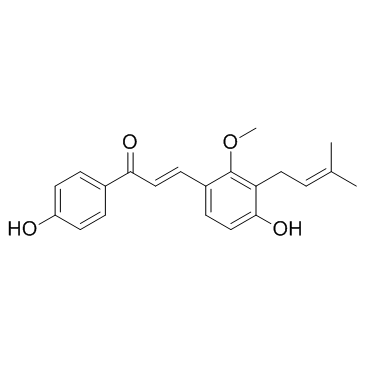| Description |
Licochalcone C could inhibit α-glucosidase, with IC50s of <100 nM and 92.43 μM for α-glucosidase and protein tyrosine phosphatase 1B (PTP1B), respectively.
|
| Related Catalog |
|
| Target |
IC50: <100 nM (α-glucosidase), 92.43 μM (PTP1B)[1].
|
| In Vitro |
Licochalcone C could inhibit α- glucosidase, with IC50s of <100 nM and 92.43 μM for α- glucosidase and PTP1B, respectively[1]. It is also indicated that Licochalcone C induces T24 cell apoptosis in a concentration‑dependent manner. Licochalcone C treatment reduces the levels of the anti‑apoptotic mRNAs (Bcl-2, Bcl-w and Bcl-XL) and increases expression of the pro-apoptotic mRNAs (Bax and Bim). The Bcl-2 family inhibitor (ABT-737) reduces apoptosis induced by licochalcone C in T24 cells[2].
|
| References |
[1]. Zhenghong Guo, et al. Chemical profile and inhibition of α-glycosidase and protein tyrosine phosphatase 1B (PTP1B) activities by flavonoids from licorice (Glycyrrhiza uralensis Fisch). journal of functional foods 14 ( 2015 ) 324-336. [2]. PENGLONG WANG, et al. Licochalcone C induces apoptosis via B-cell lymphoma 2 family proteins in T24 cells. Mol Med Rep. 2015 Nov;12(5):7623-8.
|


